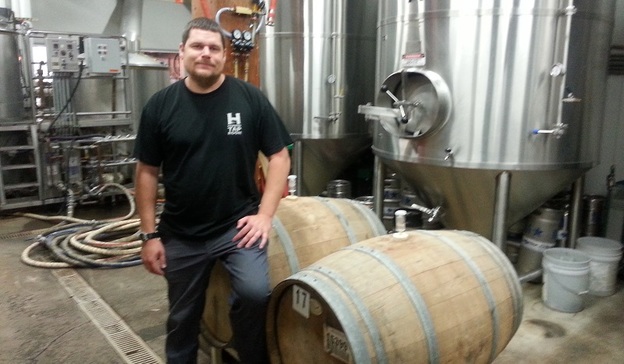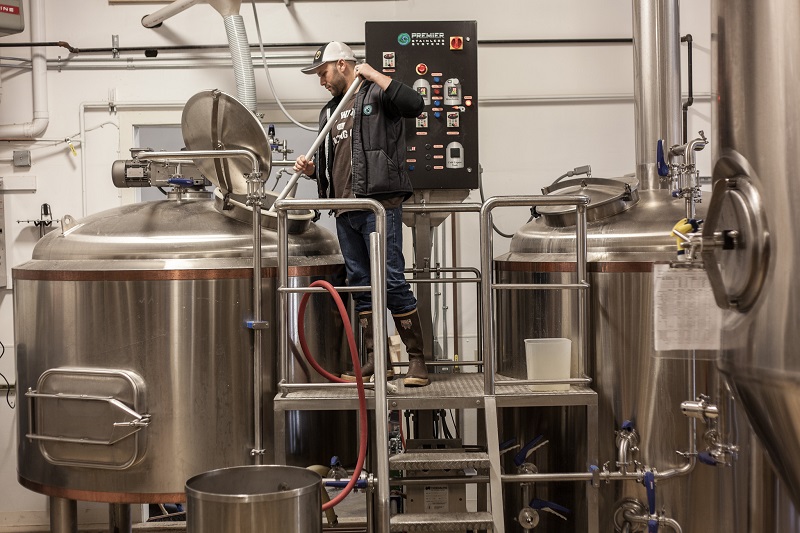|
Jeff Carlson of Harmon Brewing Co. (Photo courtesy Jeff Carlson) Re-Blogged from All About Beer Magazine Written by Bryan Roth on 1/8/16 Last March, Jeff Carlson was preparing for another busy day at Harmon Brewing Co. The head brewer had two batches of his Expedition Amber to brew, along with other odds and ends around the brewery in Tacoma, Washington. As he prepared to drain a mash tun, he cracked open its bottom drain and main manway to begin the flow of hot wort out of the 10-barrel-sized container. Something quickly went wrong, however, as pressure from a couple of extra inches of water on top of the grain forced the manway open. Malt and 175-degree water splashed onto him. The mixture went right down his front side, spilling into his right boot, where a tucked-in pant leg kept the water and grains in place. When he backed away into the middle of the brewery, the boot was sealed to his leg—his tucked-in pants causing suction with the wort. He tore off the boot, dropped his pants and looked down at his bright, red skin as he hosed it off with cool water. “There was a bunch of white stuff on my foot I kept trying to brush off,” Carlson says. “I couldn’t figure out what it was when it dawned on me. It’s my skin rolling off my foot.” Surgery would soon graft 20 inches of pig skin along his shin and foot, and Carlson would miss five weeks of work. “I’ve worked in the industry for over seven years, and you’ll hear about ‘don’t do this or that,’ but you don’t always think about the consequences,” says Carlson, who continues to receive treatment for second- and third-degree burns. The perception of working in the beer industry may be one of men and women clinking pint glasses and having a good time at festivals or in brewhouses, but just like any other industrial business, risk is involved. Which is why there’s a growing chorus of voices trying to educate brewers and staff who have been placing more importance on personal safety needs. It comes at an ideal time, as brewery injuries reported to the Bureau of Labor Statistics (BLS) have been on the rise the last four years of reported data, increasing from 160 in 2011 to 530 in 2014. Sprains/strains, chemical burns/corrosions and bruises/contusions were the most common injuries, accounting for half of cases reported to BLS in 2014. Increasingly, less experienced staff are most injured—the number of injuries reported to the BLS for employees with less than a year of service in the industry went from 40 in 2013 to 200 in 2014. Staff with more than five years of experience still managed 150 reported cases in 2014. About half of injuries in 2014 kept employees out of work for 10 days or more. The beer community isn’t averse to the worst outcome from accidents as well: Three deaths were reported in 2009 and one in 2012. “The bigger this industry becomes, the more eyes will be watching us,” says Michael Francis, owner and brewer at Payette Brewing Co. in Boise, Idaho. “For a long time, beer has stayed in this ‘hey, this is a cool job’ mentality, but now it’s turning into an industry that is about a lot more than just making beer.” Francis is focused on the idea of safety these days, as his brewery prepares for an expansion in space and staffing. Payette has grown from four to 24 employees over the past three years, prompting him to start work on a safety manual that will be shared with everyone who works at the brewery. He notes he finds himself more sensitive to potential issues these days, including how the industry may react to increased scrutiny from the government’s Occupational Safety and Health Administration. An employee at Payette Brewing Co. missed two weeks of work after falling from a ladder. (Photo courtesy Payette Brewing Co.) Earlier this year, Francis had a cellarman miss two weeks of work after a fall from a ladder, which he says meant increased work for himself and others to pick up the slack. “For years we would run up and down ladders without thinking about it, but if you take a step back and think about it, that’s a really big deal,” he says. “Something like putting on a safety harness doesn’t seem so minor now.” The Brewers Association recently began an effort to put more emphasis on safety with the hiring in April of Matt Stinchfield as safety ambassador for the trade organization. Stinchfield, who founded Ploughshare Brewing Co. in Lincoln, Nebraska, has spent more than 30 years consulting on safety, with almost 20 of them focusing on breweries. Stinchfield travels the country to meet with brewers and state brewers guilds to offer insight and expertise on making breweries and warehouses safer. He’s also working with colleagues to roll out 70 online videos to cover all facets of safety, from chemical use to lifting techniques. Conversations around safety already exist, Stinchfield says, but it’s his job to make them happen more often. “Brewers are talking about the hazards they’ve encountered and near misses because really, we’re like a bunch of guys sitting at the rural corner store comparing notes,” he says. Which rings true for Gabriel Magliaro, founder of Chicago’s Half Acre Beer Co. Looking back on the early days of his brewery, which opened in 2007, he can rattle off a list of decisions he and co-workers might think twice about today: slinging 165-pound kegs without stretching or worrying about body movement, dropping equipment near feet without steel-toed boots or getting a slight burn as they walked by vessels with heated water inside. “They’re natural hazards as part of the job, but it’s also not necessarily stuff you should have to worry about, because you can guard against them,” he says. It’s a lesson he learned earlier this year while visiting Half Acre’s new production brewery, also in Chicago. “I was rinsing out a blow-off arm on a tank, and it was packed with peracetic acid solution and water,” Magliaro recalls. “The pressure release valve pushed out and chemicals blasted me in the face, but thankfully I was wearing safety glasses.” The incident gave Magliaro an excuse to test out a newly installed eye-washing station. The brewery also has emergency showers. “I hosed myself down and I was fine,” he says. “Things happen even when you’re familiar with the process." Gabriel Magliaro, founder of Half Acre Beer Co. (Photo courtesy BrewBokeh)
For Harmon Brewing’s Jeff Carlson, work in the months since his accident meant getting used to new safety measures, from being more aware of how he uses equipment to the way he dresses—pants are always outside boots now to prevent water sticking inside. These are steps he believes are inevitable to become commonplace among his peers across the country. “Unless you’ve seen something happen or heard about it, the idea of safety can be hard to hit home,” he says. “But it will get better as more people talk about it and the consequences that can come from making a mistake.” Bryan Roth is a North Carolina-based writer. Find him tweeting about beer at @bryandroth.
1 Comment
Workplace safety should be the prior most concern for everyone. Every employee should aware of the safety guidelines implemented by the OSHA to minimize the possibilities of accidents in the workplace. The warehouse is one of the accident-prone areas and lack of safety awareness among the employees could cost a lot. So, employees should be properly trained and only experienced professionals should be hired to reduce the possibilities of accidents in the workplace.
Reply
Your comment will be posted after it is approved.
Leave a Reply. |
WinStar
|
|
© 2024 WinStar Insurance Group
13625 Ronald W. Reagan Blvd. Building 3, Suite 100 Cedar Park, TX 78613 |
IMPORTANT NOTE: This Web site provides only a simplified description of coverages and is not a statement of contract. Coverage may not apply in all states. For complete details of coverages, conditions, limits and losses not covered, be sure to read the policy, including all endorsements, or prospectus, if applicable. Coverage CANNOT be bound, amended, or altered by leaving a message on, or relying upon, information in this Website or through E-Mail.
Licensed & doing business in the following states only: Texas, New Mexico, & Oklahoma
Licensed & doing business in the following states only: Texas, New Mexico, & Oklahoma




 RSS Feed
RSS Feed


